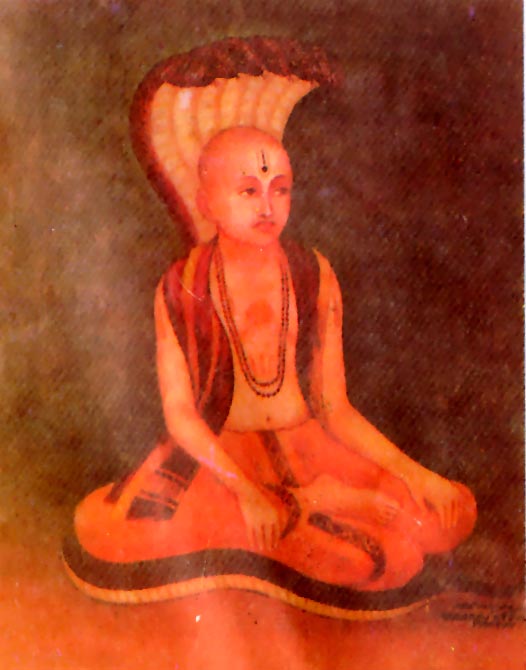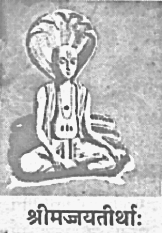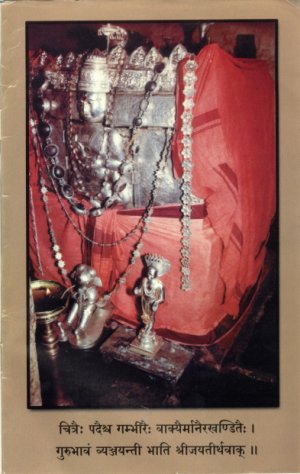
Sriyuts Sripad Akshobhya Tirtha And Sripad Jaya Tirtha.

After establishing Akshobhya Tirtha as the head of the Pejawar Mutt Sripad Madhwacarya gave him the Deity of Aja-Vithal. (Krsna standing with His hands of His hips, accompanied by Sri Devi and Bhudevi, though some say this is Krsna with Rukmini and Satyabhama, technically they are the same Persons with His expanded pleasure potencies anyway.)
It is said that Akshobhya Tirtha was in him self not a distinguished
or prolific writer, yet he stands out as an important personage in the
history of the Madhwa line (BNK Sharma. 1961. History of the Dvaita School
of Vedanta. page 229.) It is said by some that he wrote a book called Madhvatattvasaarasamgraha
of which nothing is known, yet the name suggests it was a manual of the
Dvaita doctrine.
Sri Akshobhya Tirtha who initiated Sri Jaya Tirtha (author of
Sriman Nyaya Sudha) was a contemporary of the great 'advaitin' Sri Vidyaranya
and of a celebrated 'Visistha-advaitin' scholar Sri Vedanta Desika. It
was this Vidyaranya who established the Vijyanagar Kingdom for the twins
Hakka and Bukka, and not the Madhava Tirtha that we know in our sampradaya(C.R.
Rao. "Srimat Uttaradi Mutt"). There is a historic incident which is understood
to have taken place at Mulbagal near Kolar, Karnataka. His victim was the
same Vidyaranya, the big, big 'mayavadin' scholar and 'guru' descendant
of the 'Advaitan' line of Sankara.
In the year 1336 AD., Sri Akshobhya Tirtha had a scholarly disputation
with Sri Vidyaranya on the interpretation of the "Tatvam-asi" ("You are
the same as" or "I am that") 'Shruthi' text. The extensive and elaborate
and sometimes acrimonious arguments were exchanged in the presence of Sri
Vedantha Deshika who was chosen by both as an arbitrator. Another tradition
says that all the arguments were literally written down and then sent to
Sri Vedantha Deshika whose verdict was in favour of Sri Akshobhya Tirtha.
The epigraphic evidence of this historic victory is on a commemorative
pillar of victory on a hill near Mulubagal that can be seen even today.
This was his main 'claim to fame', the dynamic way he refuted
the 'tat tvam asi - 'you are the same as', philosophy of the 'mayavadis'.
Either way the story is told, it is a stated and documented fact
that Sripad Akshobhya Tirtha was more than victorious. In fact Sripad Akshobhya
Tirtha smashed Vidyaranya so badly that in history this was considered
the turning point in the new Madhwa faith of 'Dwaitavad'. To this day the
philosophy of 'Dwaita' (dualism) has not been defeated; even the 'Adwaitin
mayavadis', knowing they are wrong, with stubborn determination, or masochistic
glee, like moths flying into the flame of personalistic knowledge, they
have yearly been coming back to Udupi to get smashed.
Sripad Akshobhya Tirtha's victory over Vidyaranya has been recorded in Jaya Tirtha Vijaya of Sripad Vyasa Tirtha, and in the Raghavendra Vijay (17th century) as well as in the Vishisthadvaitin (Sri Vaishnava) work Acarya Vijayachampu, and the epigraphic evidence carved in a pillar of stone at Mulbagal.(BNK Sharma.1961. History of the Dvaita School of Vedanta. page 230.)
Sripad Akshobhya Tirtha moved after this a little north to Pandharapur on the banks of the Bhima-rathi River, which is where he met his future disciple Jaya Tirtha. In the years to follow Akshobhya Tirtha dedicated most of his time training Jaya Tirtha in 'Dwaita' philosophy. The relationship was so nice that Sripad Akshobhya Tirtha gave his every breath to make Sripad Jaya Tirtha the most proficient and dynamic preacher since Madhwa, hence Jaya Tirtha was called the second moon of Madhwa and Tikacarya, for his many small commentaries. Sripad Akshobhya Tirtha taught him how to search out hidden significance's in the words of Madhwa which others missed, and how to write books on those points called Tikas, which further demolished the hostile 'Adwaitin' monism. Empowered by Akshobhya Tirtha he caused such a stir by even pointing out the differences in the basic understandings of 'Adwaita' philosophy of their own leading Sankarites like Vacaspati, Vivarankara, Amalananda, Citsukha and Vijnanashana, giving further strength to the Vaishnavas truths and making the 'mayavadis' all look all the more foolish.
According to popular acceptance Sripad Jaya
Tirtha renounced the world and took 'sannyasam' at twenty years of age
(reputed to be in 1368). However, due to the course of time dates have
become confused - the accepted date that Akshobhya Tirtha's giving up this
world (1365 AD) and ordination of Jaya Tirtha do not tally - we can see
from mathematical deduction that either or both dates need some adjusting.
By this time no one could philosophically touch him. He was a
genius, seeing through the foolishness of 'mayavada', and even making commentaries
on Ramanujacarya's works. He wrote about twenty books, eclipsing those
of his forerunners like Trivikrama Panditacarya, Padmanabha Tirtha and
Narahari Tirtha, but he was always humble, giving all credit to Akshobhya
Tirtha, the servant of Sripad Madhwacarya.
'Critique of Mityatwa' or 'The Falsity Of The World' was one of his main works, where he describes how this world is temporary, not false, and the 'mayavadi's' way as being really false. He points out the differences between real, unreal, temporary and permanent, concluding, ".....The co-existing of both their negations, at the same time and with reference to the same locus is, therefore, most illogical and can never be accepted by sane men." ie. The positive being this world is temporary though genuinely existing, the elements are real, and the action is real but done in connection with material nature causing reaction, which is also real but not permanent. Thus soundly defeating the 'mayavadi' philosophy around 'brahma satyam jagan mithya', various works on subjects of Vaishnavas studies and logic were written by Jaya Tirtha. Later a descendant in the 'parampara' of the name Sripad Vyasa Tirtha wrote down Jaya Tirtha's life story (Jaya Tirtha Vijaya), whereby we have found much of the details of this information.
Sripad Jaya Tirtha's previous name was Dhondo Pantraya Raghunatha (Dhonduraya,
Raghunath was his father's name), of either Viswamitra Gotra or Bharadwaja
Gotra. He was the son of a high ranking military man and had two wives.
Dhondo Pant, being like a local prince, was often seen dressed in full
armour, breast plate, helmet and all, riding his mighty war horse around
the area. He was a great horse-man, and would ride sometimes on journeys
all over the district, accompanied by his men. On one such occasion, a
hot summers day at noon, he stopped at a stream for fresh water, but his
drinking of water was not an ordinary sight. Unlike most persons taking
water, Dhondo Pant would enter into the river fully dressed (with armour,
sword, shield, helmet, plume, etc), then, whilst still mounted upon his
horse, he would drink water at water level the water directly flowing into
his mouth, being up to his neck in the water as an animal would.
On this particular day an incredible meeting took place. On the
other side of the stream was Akshobhya Tirtha, watching this extraordinary
sight. Sripad Akshobhya Tirtha called to the horseman, "Horseman, you drink
water just like a bullock," and these few words put the horseman into a
strange, deep, all-revealing state. Suddenly philosophical questions, which
made the young horseman's mind spin into thoughts of his previous births,
came to mind. Dhondo Pant could now remember his time spent with Acarya
Madhwa, but he had been covered for so many years thinking that he was
the son of a nobleman. Now he could remember all kinds of incidences that
made his hair stand upon end in horripilations. He gained some intense
realisations which enabled him to see quite clearly how previously he was
actually the bullock who was used to pull around Acarya Madhwa's books
as Madhwa travelled and preached all over. But most special and precious
to him, he could actually remember Madhwa, his commanding but sweet voice,
elaborating upon the various Vedic literatures.
There is an interesting story in this connection, Sripad Madhwacarya
would quite often glorify this bullock, by saying to the assembly that
actually this bullock listened better and assimilated the philosophy quicker
than any of Madhwa's other students. Wherever Madhwa would preach the bullock
would turn up, ears pricked up and forward in an attentive mood; his faithfulness
and loyalty knew no bounds. Sripad Madhwacarya could sometimes be heard
saying that simply by his attentive hearing this bullock was making great
advancement. These kind of statements made some of Madhwa's 'sannyasam'
disciples quite envious. So much so, that some of them cursed the bullock
to die from snake bite. The merciful Madhwa heard about the curse and blessed
the bullock that he would not be harmed.
As per the curse, the snake came and bit the bullock, and amazingly
the snake died! Everyone was awe struck, but could at once appreciate the
motive, and kindness, and protection of Madhwa. He was protecting his dear
devotee who had surrendered his life to the service of Madhwa's preaching
mission.
After some years the bullock passed away of natural causes, old
age.
Tradition has it that in actuality this was no ordinary bullock in the first place. He was reputed to be a partial incarnation and joint expansion of both Indra, the King of the demigods and Lord Ananta Sesa. So again it was no ordinary thing what had happened - the bullock taking his birth in a family of greatly pious 'kshatriya' kings in Karnataka, and being further brought up to know the Vedic literatures according to the teachings of Madhwa. Obviously the Lord deemed it now the right time to utilise his self realisation, of what he had heard, of where he was up to, and again what had been developing in society, for his birth and subsequent meetings to be invoked.
Anyway back to the river, Dhondo Pant, standing in the water, addressed
the humble and aged mendicant Sripad Akshobhya Tirtha as follows. "My dear
sir, who are you, from where did you come, and how do you know me? Simply
by the words emanating from your mouth my life has changed. You must be
my 'guru'; you have opened my eyes which were blinded for so long. O my
guide, you have shed my ignorance of my real self, and nature. Please tell
me more. Please instruct me, be my mentor, and so doing make it that my
life can become perfect. O 'Gurudeva', please save me from the clutches
of repeated birth and death."
Dhondo Pant was so amazed and became so agitated from gratitude
by this meeting that he did not want to leave his side. In fact he asked
to become Sripad Akshobhya Tirtha's formal disciple right there and then.
The other horsemen also joined Dhondo Pant in crossing the river
and spent some time in discussion with him. But being of a different calibre
they returned to the estate of his father without Dhondo. Riding at break
neck speed, all day the news soon reached the boy's father who later personally
went to reclaim his son, and took him home.
To save any further quarrel, Dhondo followed his father without
any protest, but even though the enraged father came to collect him, Dhondo
had left his heart with Akshobhya Tirtha. Thinking deeply Dhondo devised
his plan, and on his return home, and to start with he had his marriage
consumed.
An amusing story is revealed of the night that he returned to his two wives. When Dhondo Pant's beautiful and young wife entered the bed chamber to be with her husband, to her surprise there was an incredibly magnificent cobra sitting coiled up on the bed. The snake swayed mystically as though one absorbed in trance. Enchanted by the sight, she, out of respect for the mysticism of the whole event, paid her prostrated obeisances before the serpent, but soon fear overcame her and she fled the room screaming, and fainted on the floor just outside.

In due course, Dhondo Pant was initiated and given the order of 'sannyas', and the new name, Jaya Tirtha. This happened in the year 1368 AD, thus making the possible year of his birth 1348 AD., or 1346. (1167 Sakabja Era)(A.C.Bhaktivedanta Swami PRabhupada. Caitanya Caritamrta. Madhya-lila 9:245.purport - Bombay Gazzette.)
Some do not agree with this story, saying that it would not have been allowed in the strict Brahmin society of the 14th century. But whether one relies on one's own puny logic and knowledge of local culture and history, or accepts the story as explained by Sripad Vyasa Tirtha or not, the link was there, and soon he came back to Akshobhya Tirtha who accepted him as his 'sannyas' disciple and gave him the name Jaya Tirtha. He then started to study 'shastra' from Akshobhya Tirtha intensively until Akshobhya Tirtha finally passed away shortly after, ....his mission in life now completed.
Sripad Akshobhya Tirtha who is believed to be a Rudra-amshi (a partial incarnation of the aspect of Lord Shiva), has his 'brindavana' (samadhi) on the banks of river Kagini in a place called Malkeda (Karnataka).
Sripad (Tikacarya) Jaya Tirtha toured several times all over India, destroying the philosophy of the impersonalistic rascals. He was undefeated and became well known as the pure Vaishnava Acarya that he was.
He spent his closing years at Malkhed (or Manyakheta), once the capital of the Rashtrakuta kings of Karnataka, in the Gulbarga district, Mysore state. This is said by some to be the place where Jaya Tirtha passed away on the Pancami (fifth day) of the dark fortnight in the month of Asadha (June-July) 1388 AD at the age of forty. However, there is also a samadhi tomb of his in northern Karnataka which I have personally seen. On this samadhi tomb at Anagoendi (Hampi) on the Tungabhadra river, next to the 'samadhi' of Padmanabha Tirtha, there are carvings of him as a 'kshatriya' prince, and next to that as a '' mendicant.

There is a little more to be relished on Tikacarya Jaya Tirtha as we
look at latter day followers of Sripad Madhwacarya at the end of this book.